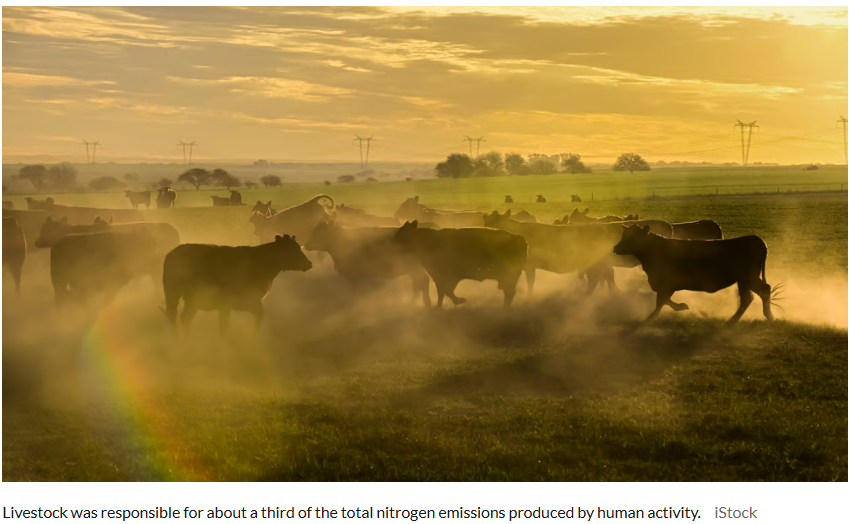Livestock was the main contributor to nitrogen emissions, along with synthetic fertilisers, land-use change and manure emissions

Humans currently add around 150 teragrammes (Tg) of reactive nitrogen to the Earth’s land surface each year through agriculture and industry. This amount is more than double the pre-industrial rate, according to a new report.
Climate change could contribute to this rate, raising it to about 600 Tg per year by 2100, which could further increase the levels of nitrogen loss into the environment, the report by the Food and Agriculture Organization of the United Nations, suggested.
NUE is the ratio of nitrogen recovered in the final output to the total nitrogen used as input. Increasing NUE aims to recover as much of the nitrogen input as possible in the final product, thereby minimising the amount of nitrogen lost in the production process, according to the report released on January 20.
Livestock was the main contributor to nitrogen emissions and was responsible for about a third of the total nitrogen emissions produced by human activity. Synthetic fertilisers, land-use change and manure emissions were the other main causes of nitrogen pollution, the report said.
Global nitrogen flows have already surpassed the planetary boundaries — a term referring to the environmental limits within which humanity can safely operate, and the degree of this exceedance has dramatically increased since 2015.
However, the report pointed out that while the exceedance of the global nitrogen planetary boundaries was evident, regional heterogeneity needs to be considered, which requires different formulations of policies and improvement options suitable for each set of local conditions.
On one hand, the rise in nitrogen fertilisers over the past century has significantly contributed to enhancing agricultural production and bolstering food security and nutrition for an expanding global population. On the other hand, improper use of nitrogen can severely damage air, water and soil quality, result in biodiversity loss and exacerbate climate change.
Global crop yield has been rising steadily from an average of 19 kg of nitrogen per hectare per year in 1961 to 65 kg N/ha/year in 2022. Nitrogen use efficiency, however, declined from 56 per cent in 1961 to 40 per cent in the 1980s and has since increased again to 56 per cent in 2022.
As per the report, nitrogen pollution was the most severe in North America, Western Europe and certain Asian countries “where fertilisers have been extensively used and misused for decades”.
NUE ranges varied by country: In Southeast Asia, it decreased significantly from 65 per cent in 1961 to 45 per cent in the 1990s, to increase again to 54 per cent in 2022. In North America, NUE first decreased from 65 per cent in 1961 to below 50 per cent in the 1980s, then increased to 69 per cent in 2022.
NUE also varied at the crop level. For example, soybeans had an NUE as high as 80 per cent in 2010, while fruits and vegetables had NUEs as low as 14 per cent in the same year.
The report also offered a series of recommendations. It advised that the fertiliser industry should take urgent action to reduce greenhouse gas emissions during the production of mineral nitrogen fertiliser and encourage the minimisation of wasteful losses during storage, transport and land application.
National governments, authors of the report suggested, should encourage the widespread use of biological nitrogen fixation (a process in which nitrogen gas from the atmosphere is symbiotically fixed into the tissues of certain plants) in locally appropriate crop rotations using leguminous crops, such as soybean or alfalfa.
National governments should create guidelines to assist livestock farmers in adopting the best manure management practices, concentrating on minimising wasteful nitrogen losses to the environment and enhancing its effective use in productive agriculture, the researchers recommended.
Agrifood system policies, they added, should encourage the use of organic nitrogen fertilisers to enhance sustainability. They should also promote spatial planning by redistributing livestock, reducing the number of livestock in areas with high geographical concentration and promoting circular bioeconomy approaches.
The report also advocated that national governments should promote the integration of sustainable nitrogen management in nationally appropriate mitigation actions and nationally determined contributions, including targets to reduce nitrous oxide from agrifood systems to keep in sight the Paris Agreement goal of restricting global warming to 1.5 degrees Celsius above the pre-industrial period.
National governments should alsi set national commitments to reduce nitrogen pollution, including ammonia and nitrates to meet global biodiversity goals, the authors addedd.
Article Credit: downtoearth